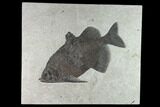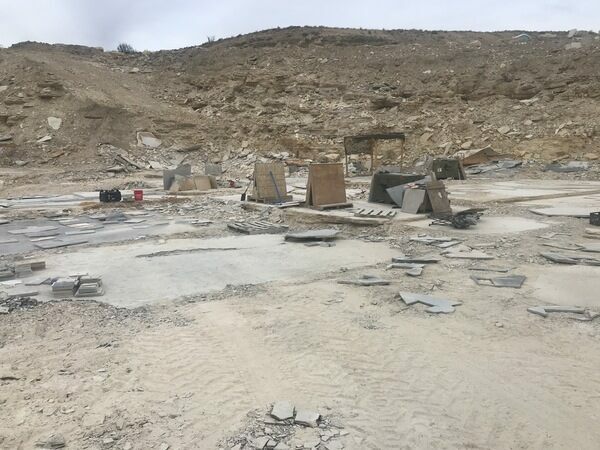This Specimen has been sold.
14.3" Fossil Fish (Phareodus & Priscacara) Plate - 18 Inch Layer
This is a darkly preserved, 11.6" long Phareodus from the famous 18 inch layer of the Green River Formation in Wyoming. It's nicely centered on an unbroken 16.6 x 9.9" slab of shale, and the preservation is dark and detailed. There is a 4.3" long fossil Priscacara (Cockerellites liops) that overlaps the Phareodus fish. This specimen is backed with plywood and includes a strap hanger for easy hanging.
About Phareodus
Phareodus is a genus of predatory freshwater fish found in the famous Fossil Lake deposits of the Green River Formation in Wyoming. It had a mouthful of sharp pointy teeth, making it a voracious lake predator. In fact, the name Phareodus actually means "to have teeth". Spines from other fish such as Mioplosus and Priscacara have frequently been found preserved in their stomachs.
Phareodus is a genus of predatory freshwater fish found in the famous Fossil Lake deposits of the Green River Formation in Wyoming. It had a mouthful of sharp pointy teeth, making it a voracious lake predator. In fact, the name Phareodus actually means "to have teeth". Spines from other fish such as Mioplosus and Priscacara have frequently been found preserved in their stomachs.
About The 18 Inch Layer Of Fossil Lake
Specimens like this come from the coveted 18 inch layer of the Green River Formation, which produces darker and more detailed fish than the majority on the market. The rock from this layer is much harder and more durable than other layers in the formation, likely due to its initial deposition conditions in deep water. Because of these conditions, fish found in the 18-inch layer can be extracted whole and in excellent condition. This layer is typically collected at night using low-angle light to see the bump in the rock that the fish's backbone creates. They then cut these fish out and take them to a lab where the fish, which may be up to an inch under the surface of the rock, are meticulously extracted under microscope with hand tools.
Specimens like this come from the coveted 18 inch layer of the Green River Formation, which produces darker and more detailed fish than the majority on the market. The rock from this layer is much harder and more durable than other layers in the formation, likely due to its initial deposition conditions in deep water. Because of these conditions, fish found in the 18-inch layer can be extracted whole and in excellent condition. This layer is typically collected at night using low-angle light to see the bump in the rock that the fish's backbone creates. They then cut these fish out and take them to a lab where the fish, which may be up to an inch under the surface of the rock, are meticulously extracted under microscope with hand tools.
SPECIES
Phareodus testis & Cockerellites liops
LOCATION
Kemmerer, Wyoming
FORMATION
Green River Formation, 18 Inch Layer
SIZE
11.6" fish on 14.3 x 12.2" shale
CATEGORY
SUB CATEGORY
ITEM
#132874
We guarantee the authenticity of all of our specimens.
 Reviews
Reviews













